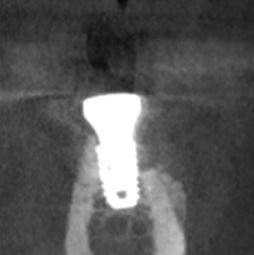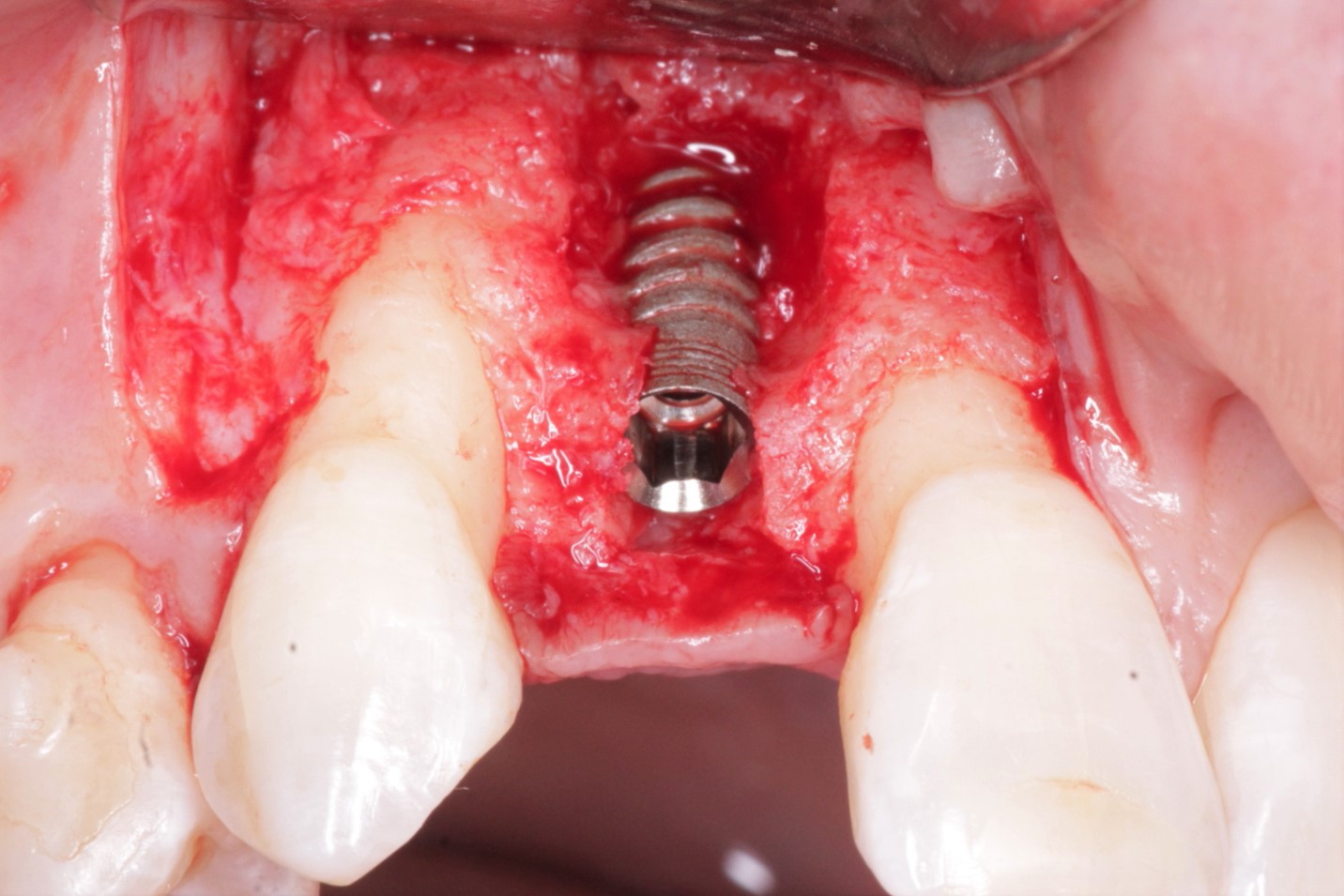Implants Placed Supra-Crestally: How to Manage this Restoratively?
Dr. AD, a general dentist, asks:
I do not surgically place implants but I restore them. Lately I have had a very high volume of single crowns and fixed partial denture restorations. Many of the implants which should have been placed at the alveolar crest have been placed supra-crestally – slightly raised. I feel this give me a less than desirable emergence profile (apple on a stick) and most importantly, patients complain about food impaction in the interproximal areas. What are your feelings on this? I always use custom abutments but still I am not happy with the results. Is there any way I can manage this problem restoratively? Please advise. Thank you in advance.
13 Comments on Implants Placed Supra-Crestally: How to Manage this Restoratively?
New comments are currently closed for this post.
Dr. Dennis Nimchuk
4/19/2010
Depending on the type of implant, it is sometimes possible to place and secure down an abutment with the appropriate final torque and then prepare apically onto the implant body and then make a direct impression.
vj
4/19/2010
quite right Dr Nimchuck.have had to do this a few times and has worked very well.
Peter Fairbairn
4/20/2010
Follow the advice of Dr Nimchick , emergence profile is not an issue in implants thus you can ridge lap to a certain degree. In most molar cases to get the ideal tooth emergence profile you would need to place the implant way bellow the crest which will lead to other issues.
Richard Hughes, DDS, FAAI
4/20/2010
I agree with Dr. Nimchuck. Apical prepping is a simple solution to this issue. I have done this numerous times.
Andriy Yegorovykh
4/20/2010
I would not be happy to restore such implants.
Beautiful, technical and simple process of restoring implants is being compromised by human factor, namely, your implantologist.
I would strongly advice you not to prep implants, as trying to achieve pseudo-aesthetics you weaken the implant.
Colleagues' advice should be followed once in 1000 implants when caught in specific circumstances, not routinely. In this case i would use crown without margin preparation.
peter hunt
4/20/2010
I'm surprised at these responses. Preparation of the collar of the implant is liable to weaken it considerably and leave it much more liable to fracture. An already compromised situation is liable to turn much worse.
It's better to face up to the situation at the outset. Tell the surgeon where you desire the implant platform to finish. If they still come back too high then find someone who can place them correctly.
Pankaj Narkhede, DDS; MDS
4/20/2010
"Apical prepping is a simple solution to this issue." This is correct. This actually makes an implant and a crown a single unit like a tooth. The same principle is/was used in the the implant system introduced by Dr. Tatum (Unipost). This is true considering the crown root ratio and sufficient available bone is used to place an implant. Do not make a deep collar. Knife edge flush is enough with a high nobel metal collar (.5 mm) all around.
Carlos Boudet, DDS
4/21/2010
Extending the preparation of an abutment onto the surface of the implant is a compromise, and it can definitely weaken the implant, depending on the thickness of the implant, the type and depth of the preparation etc...
If you are doing this on a routine basis, it seems that you need to discuss this with the doctor doing the surgery.
Richard Hughes, DDS, FAAI
4/21/2010
In theory yes. When you start placing and restoring alot of implants, yoi will notice that from time to time things are just not perfect.
Frderick Shaw
4/21/2010
I am in total agreement with Dr. Hunt. When you surgically place an implant you do not close doors behind you with "creative solutions" and indeed make an already non-ideal situation irreversible and deny your patient futher opotunities with their investment. As a dentist it is our job to anticipate concerns regarding each patients presentation and not recommend solutions which jeoprodizes and compromises our patients investments. You can always change altered abutments but it is unethical to take it upon yourself to alter something that is relatively non-reversible. You need to get together with your surgeon and discuss solutions to these challenges, explain to patients already in progress the possibility of food traps and emmergence profile issues. This type of problem in my mind does not include creative thinking at the expense of your patients investment. What happens throughout the course of a patients life regarding future options involving more missing teeth and additional implants. This is a medical /legal /ethical realm when you alter the implant body.
K. F. Chow BDS., FDSRCS
4/21/2010
C'mon guys! Most two-piece dental implants are placed in a one-step one-piece style anyway to avoid having to do a second surgery. We are still living with the residual rumbles of Professor Branemark's 2-piece approach because of his rightful obsession that osseointegration should be left in peace until it osseointegrates. But since then, we have improved the surfaces and threading to ensure faster and surer osseointegration without having to wait for the classical 6 months. And we are getting away with placing them sticking through the gums so that we need not cut twice! Thus my fair presumption that most implants are placed in a one-piece style anyway. In short, let's move on ahead to the next level.
Having said that mouthful, the begging question is why we are not making most implants one piece anyway, and thus with a smaller diameter and just as strong if not stronger since it is solid without having a weak screw to link the 2 pieces. Then, we can avoid having to make a big hole in the gums and make a small one instead. A small one will certainly mean faster healing and less likelihood of peri-implantitis in the future.
Lastly, and emphatically..... THERES NOTHING WRONG WITH AN APPLE ON A STICK! They taste excellent and look just as good judging from all the nice pontics we use to make in the past. And friends, they are easier to clean compared to a large round sloping volcanic crater in the gums..... and definitely will allow less pathogens in.... and the few that do make it will be destroyed by the heroic knights of our incomparable immune system. Think how easy it is to defend a castle with a narrow door than a castle with a hugh one.
Cheers!
Dr. VAZIRI from IRAN
4/24/2010
Regard to doctor AD's mentions and other DOC.
comments on these matter I didn't see any comments
appearance to dr. Ad questions, furthermore these
explanations come from text books and I'm still very
young for comments.
What is the fundamental of implantology? you MUST
place implants in the hard tissue(bone) with enough
supporting bone with no EXCEPTION,so placing implant
in supra-crestally means placing implant in soft
tissue and later time you would be sorry .Now answer to
your first questions.
-Receiving an implat supra-boney;no dote change your
surgen
-Food impaction; As far as you mention "you have high
volum of crowns and fixed partial denture
restoration" if a tooth is in contact with adjacent
teeth(2/3 on occlusal or 1/3 on incisal) mean no
food impaction. In my view this is the case, because
you have same problem with Fixe partial denture also.
-RESTORATION an implant or FPD, it would be food scap
into interproximal under the level of the occlosal
contat by chowing and tongue moving is NOT food
impaction,so if this is the reason,it's something
common,you rich the goal and should be excellent job.
Ofcourse,most of the patient they get complain,but
you have to explain to them an academic advantages
for this circumstance and let them know about
priodontal disease, you are a doc. isn't it? in other
view, if you only have problem with food impaction on
implant you should attend in dental LAB. or change
your Lab for some reason. I'm doing this for more
than 10 year even with simple case and let you know,
if you restore an implants you have to know dental
technician also .
-Restoring an implant it's not simple.The most
important thing is CONTACT with adjacent teeth
especially when adjacent teeth have meso-distaly
angulation ( most of them they have).It's would be
two out come possibility.
1- If you fit contacts with adjacent teeth on 2/3
occlosal or 1/3 insicialy(what's the book says), your
implant's abutment can not seated(overcontour).
-If you fit contacts with adjacent teeth more
cervicaly,definitely you have food impaction on those
interproximal areas(because you have high open margin
on occlosal surfaces and lock of blood
circulation,cleaning and start priodonal pockets
(which I discuss on interproximal).For those cases
it's better you restore contacts on implant with
adjacent teeth on more OCCLOSAL or INSICIALY at the
level of MARGINAL LINE ANGLE on meso-distaly.Now your
last quesion regard to custom abutments,and
impressions.
- Use custom abutments is top job if your go by these
steps.
1-One piece abutment posts,used if abutment need not
be change on laboratory casts.
2-one piece implant post,used if it is desirable to
change on laboratory casts. this abutment should have
a flat side if angle correction may be nacessary.
3-Tow piece implant impression post, used to orient
antirotational features or to take impressions of
very divergent implant.
Good luck to you.
Apr,25.2010
Dr.Vaziri- Iran Tehran
Shirley A. Colby
9/15/2010
First, you have already identified your concerns,
and the SOURCE of your concerns. NEXT, you have to INFORM that source: SPECIFY your expectations and if he
can not abide by them, then find somebody who could.
Afterall, it is your reputation that is on the line!
Why settle for less, when you can do better? Why subject yourself to undue stress when the solution is as simple as EFFECTIVE communication?
As dentists, we owe it to the patients, the
profession and to ourselves, to do the best we can,
under any given circumstances, whenever possible.
Dentistry is not just about a job... It is about making a difference in the lives of others.
Lastly, why draw attention to that "apple on a stick," when it is within your ability to CAPTURE THE
BEAUTY OF A SMILE? Think about it.
Warmest regards,

















